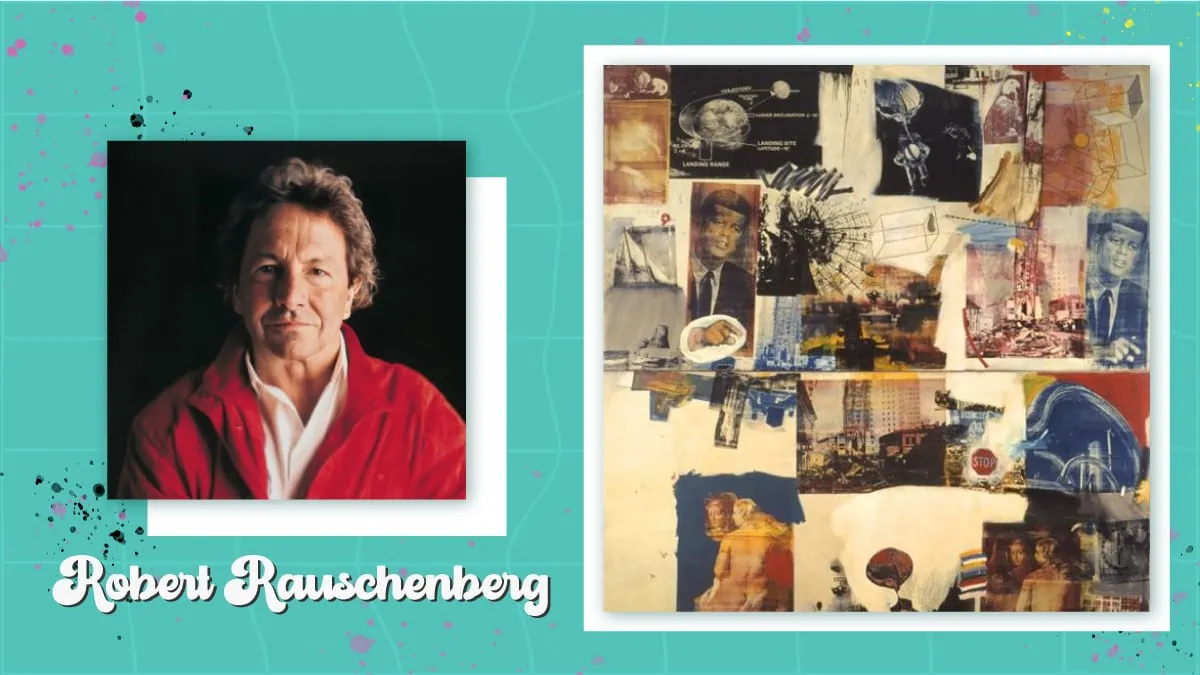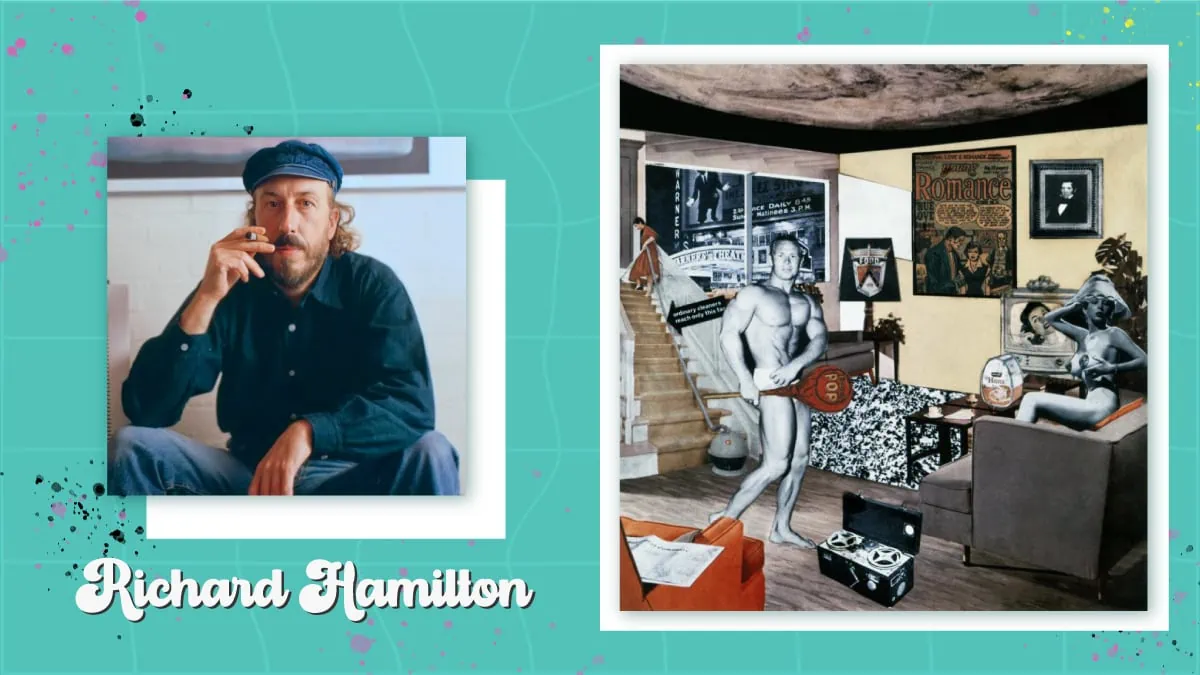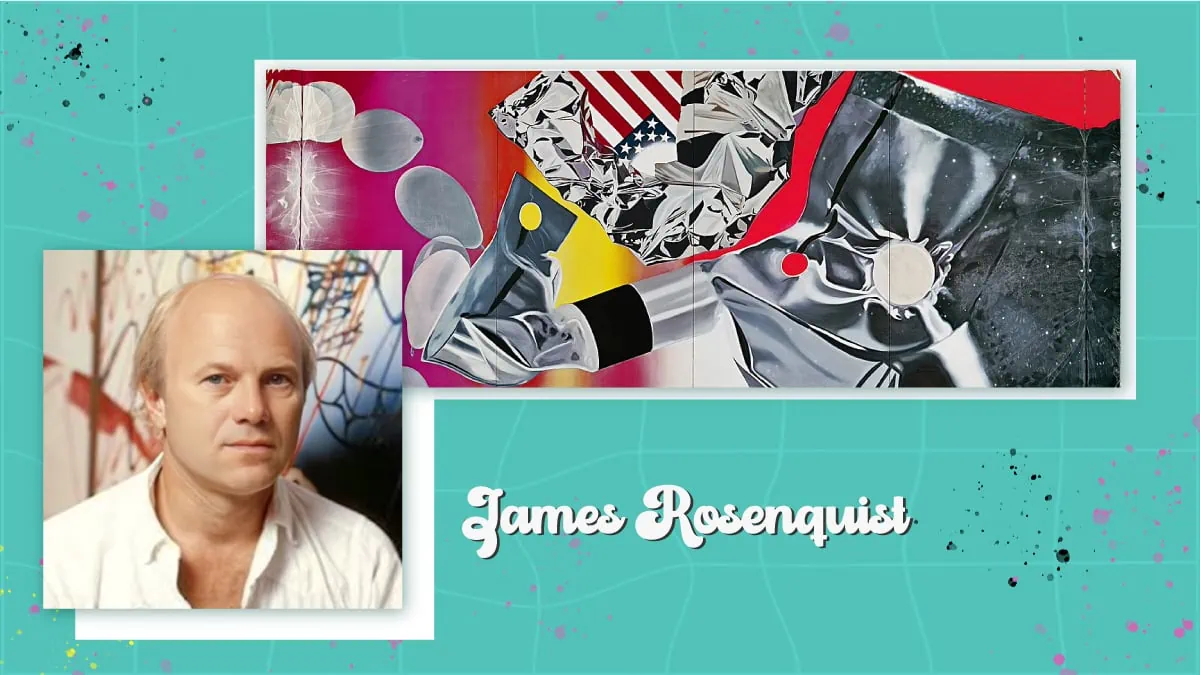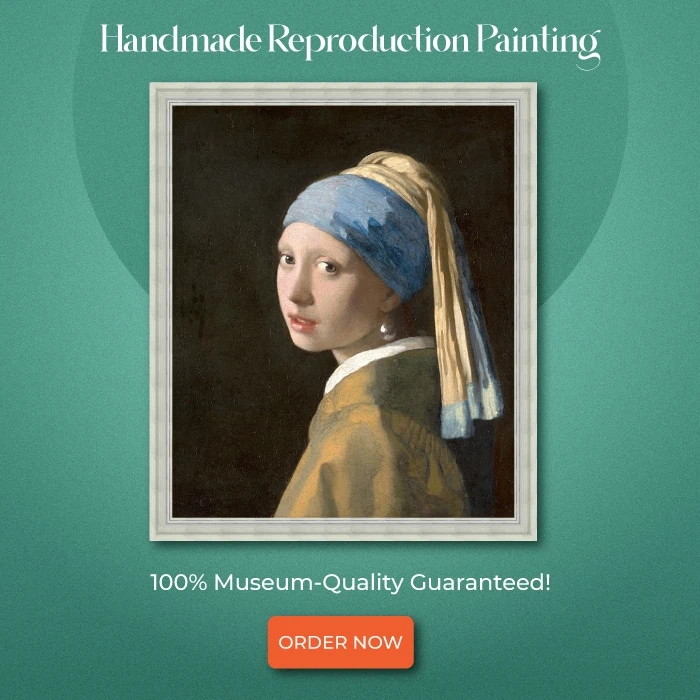Table of contents
- 1. Andy Warhol (1928-1987)
- 2. Keith Haring (1958-1990)
- 3. Roy Lichtenstein (1923-1997)
- 4. Eduardo Paolozzi (1924 – 2005)
- 5. Robert Rauschenberg (1925-2008)
- 6. Claes Oldenburg (1977 – 2009)
- 7. Richard Hamilton (1922-2011)
- 8. James Rosenquist (1933-2017)
- 9. David Hockney (1937 – present)
- Concluding Thoughts
- FAQs
Pop art commenced in England in the late 1950s.
Among the early artists of pop art were Richard Hamilton, Eduardo Paolozzi, and Peter Blake.
Soon after, the Pop Art movement expanded to New York with artists like Andy Warhol and Roy Lichtenstein.
Pop art placed both fine art and low culture on the same pedestal. It seamlessly blended the two together.
The themes that were a crucial part of youth cultures such as rock and roll, television, movie stars, and comic books were all part of famous pop art.
Pop Art, the movement also focused on consumerism after World War II and the advancement of home appliances and popular products.
A few decades later, the influence of pop art artists was found in almost every aspect of our modern society.
The Pop Art movement is popularly known as the direct descendant of Dadaism based on how it mocked the established art world using popular culture.
There were numerous artists of Dadaism whose contribution led to the birth of dada movement which later give rise to the pop art culture.
The goal of the pop art movement was to elevate popular culture to another level—fine art, thus blurring the lines between high and low forms of art.
That’s why artists of pop art believed that there shouldn’t be a hierarchy of cultures and any source could inspire art.
A list of pop art artists openly challenged and questioned the traditions that fine art brought forth and introduced a completely new world of aesthetics.
Today, through this article we’ll give you a glimpse into the sixteen famous Pop Art artists whose work influenced and formed the colorful and vivid world of Art.
These artists of pop art not only left a significant mark on the world of art but also redefined our visual perspective of popular culture across the world.
1. Andy Warhol (1928-1987)

Andy Warhol is one such name that became synonymous with Pop art.
He was also popularly referred to as the “Pope of Pop”.
Andy Warhol Campbell’s Soup Cans and Gold Marilyn Monroe brought him worldwide fame.
One of the many groundbreaking things in his career was his exhibit video as an artwork, which was almost revolutionary in the 1960s.
His drawings were usually comic, fancy, and whimsical, which was quite contrary to the cold and abstract mood of his Pop art.
Andy Warhol as a pop artist played a crucial part in the breakdown between high and low art forms.
Andy Warhol’s artworks led the beacon in these developments which ultimately influenced countless other artists to join the movement.
His style was completely opposite to the traditional art community and was greatly unfavored by art critics within the prevailing style of the era.
His pop art painting Marilyn Diptych gave voice to celebrity culture as no other artists’ works did.
Warhol’s works are amongst the most expensive pieces of art ever sold across the globe.
He has left behind a legacy as one of the world’s most famous artists of pop art that still remains to this very day.
(Also Read: 8 Artists of Romanticism Who Explored Darker Depths of Human Psyche)
2. Keith Haring (1958-1990)

Keith Allen Haring was an American pop artist known for his illustrative depictions of figures and symbols.
He is the mind behind the creation of one of the most widely recognized visual languages of the 20th century known as animated imagery.
When you dive deep into Keith Haring’s artworks, there are no mistakes about it, you would instantly know whether it’s Haring or not.
His iconic characters and signature style are still popular in today’s society.
Just like other artists of pop art he was in an effort to break down the barriers between high and low art, and create art that is seen as one.
Haring’s use of simple imagery was his way of making a cultural commentary on issues including AIDS, drug addiction, illicit love, and apartheid.
Being a visual pop artist and an activist he was of the view that depicting serious issues could be fun.
It just needs to be communicated through highly cartoony images and fresh choices of colors.
He believed that artists should not just aim to grab the eyes and minds of viewers but also get them to enjoy themselves through art.
He used chalk to etch his signature designs onto the walls.
His masterpiece Radiant Baby is one such magic created on the wall, which to him was one of the purest and most positive human experiences.
With an aim to make his art even more accessible to the common mass.
He opened a Pop shop in Soho that sold various items of merchandise with his work printed on them.
His art then became accessible to a larger audience, which bridged the gap between low art and high art.
Suggested Read: Artists of Romanticism
3. Roy Lichtenstein (1923-1997)

Roy Lichtenstein was one of the most famous pop artists of the Pop Art era.
He was greatly inspired by comic strips and incorporated this style into most of his works.
Roy’s work was subject to criticism since it was banal and unoriginal.
Roy was a firm believer in the fact that artists find their beacon in their surroundings rather than their own exploration of feelings.
Most of Roy Lichtenstein’s masterpieces were mass-produced images that explored the fine line between art and entertainment.
His signature use of Ben-Day dots, as in Drowning Girl (1963), was an emphasis on methods of mechanical reproduction that was a common trait of popular culture.
When it was about eradicating the skeptical view of commercial styles and subjects introduced by Abstract Expressionists. Roy’s pop art played a pivotal role in it.
Suggested Read: Famous Mexican Artists
4. Eduardo Paolozzi (1924 – 2005)

Eduardo Paolozzi was most known for marrying Surrealism’s early principles with heroic new elements of popular culture.
His artwork oscillated between society’s advancements’ darker and lighter consequences and their so-called progress.
On the other hand, his collages were brighter in nature, which reflected the way contemporary culture and mass media swayed individual identity.
He was mesmerized by the relationship shared between humans and machinery.
He would often depict biomorphic forms in his work as indicative of both.
In 1952, Paolozzi began showcasing his collages made earlier in Paris to his peers, and his career took a fundamental turn.
Strains of each Surrealism and Cubism can be seen throughout his work.
As a pop art artist, he’d pair disparate imagery and disjointed form to portray the idea of a man as a mere collection of parts in an overall machine.
His artwork, “I Was a Rich Man’s Plaything” (1947), gained massive popularity and was regarded as an inspiration to a future group of British pop artists.
Suggested Read: Famous Renaissance Artists
5. Robert Rauschenberg (1925-2008)

Robert Rauschenberg’s profound blending of materials and methods brought him to the forefront of several art movements, including pop art.
He was greatly influenced by the new commercial printmaking processes of the time.
He’d collect discarded materials from New York streets and use them for his work.
Later, he started transferring photographs and images to the canvas.
The multiple repetitions of images soon became an innovative tool in the creative hands of Robert Rauschenberg.
His pop artist paintings with photographic silkscreen, such as Skyway, mirrored our experience of mass media, capturing visual noise in an ironic allegory framework.
He believed that a painting has the power to relate to both art and life, and his goal was to work towards bridging the gap between them
Rauschenberg’s experimental style expanded the traditional boundaries of art, opening up new doors of exploration for future artists
Suggested Read: Famous Baroque Artists
6. Claes Oldenburg (1977 – 2009)

Claes Oldenburg has been ruling the world of pop art sculpture since the early 1960s.
When most pop artists imitated the flat language of billboards, magazines, and television, Oldenburg worked with two- and three-dimensional mediums.
His three-dimensional plaster models and soft fabric forms turned pop art into the realm of sculpture.
There were some ideas in Oldenburge’s monumental public art, such as his concept of enlarging an everyday object and placing it in a landscape.
He was greatly influenced by the Surrealists such as Magritte, Dalí, and Ernst, which is evident in his sculptures, which are Surrealist dreams made real.
His artworks focused on reversing the traditional relationship between viewer and object, rather than on how ordinary the subject is.
His first monumental outdoor sculpture was Lipstick (Ascending) on Caterpillar Tracks.
In his embrace of consumer appetites in pop art, Oldenburg aimed to break new ground by giving audiences what they wanted.
7. Richard Hamilton (1922-2011)

Richard Hamilton, popularly known as the “Father of the Pop Art Movement,” was a visionary who outlined its aims and ideals.
For Hamilton, modern pop art was more than just a movement.
For him, it meant total immersion in popular culture: movies, television, magazines, and music.
Hamilton was a constant reminder that pop art originated in England.
His collage is called Just What Is It That Makes Today’s Homes So Different, So Appealing? portrays a living space cluttered with a plethora of objects of desire.
Although his consumer catalog displayed some level of playfulness, it also showcased the horrible angst of that age.
His aptitude for public spectacle and profane approach to cultural icons live through the work of many great artists of pop art who were inspired by him.
8. James Rosenquist (1933-2017)

Rosenquist was one of the influential figures of the movement and is popular for his colossal collage paintings.
His early works were considered symbolic of a burgeoning consumer culture in America during the 1960s.
He applied the Surrealist practice of juxtaposing subjects that were not closely related to fragmented commercial images and ads.
He layered popular motifs such as Coca-Cola bottles, packaged foods, and lipstick mouths with complexity.
Through them, he enlarging an everyday object and placing it in a landscape
His large-scale Pop Art paintings, like the Flamingo Capsule, changed the visual language of commercial work on canvas.
Many popular pop images and symbols of advertising language and pop culture ended up in his work.
He was an artist who was way ahead of his time and moved beyond his early fascination with popular culture and mass media.
His artwork was such that it addressed new issues, which is why his work is considered relevant today.
Suggested Read: Famous Italian Artists
9. David Hockney (1937 – present)

David Hockney is considered a leading figure among Pop Art artists in Britain.
Hockney’s style includes a wide range of influences, from Baroque to Cubism, making him different from other pop artists.
Yet another unique factor about him was that he depicted the domestic sphere in his personal life and that of his friends.
He was openly gay and has prevailed as a loyal advocate for gay rights.
Hockney used bright greens, purples, pinks, and yellows in his artworks.
This was a declarative statement in support of the sexual freedom that every human deserves.
One of his most important large-scale works, A Closer Grand Canyon, gained a lot of attention in the pop art era.
His work has played a major role in reviving the practice of figurative painting in pop art history.
Concluding Thoughts
These artists of pop art stood up for what they believed in and didn’t let anything stop them.
What began as a revolt against the dominant approaches to art has paved the way for numerous artists to change the preconceived notions of art and start a new art revolution.
If any of these artists of Pop Art have inspired you, then celebrate them with your favorite Pop Art masterpiece from the era.
Hello Readers,
Thank you for reading this article about artists of pop art all the way to the end.
Please let us know in the comment section below if you know some more interesting facts about these Pop Art artists.
You can also check out our new blog on Famous Paintings of Still Life.
Also, don’t forget to follow us on Instagram, Facebook, and YouTube.
FAQs
Andy Warhol is labelled as the Father/King of Pop art movement.
The artworks that come under Pop Art is called pop art because they uses elements like mirrored images, graffiti, media imagery, etc.
Pop art movement began in mid-1950s in Britain and in the late 1950s in the United States.
Pop Art is an art movement that emerged in the mid-1950s in Britain and in the late 1950s in the United States






